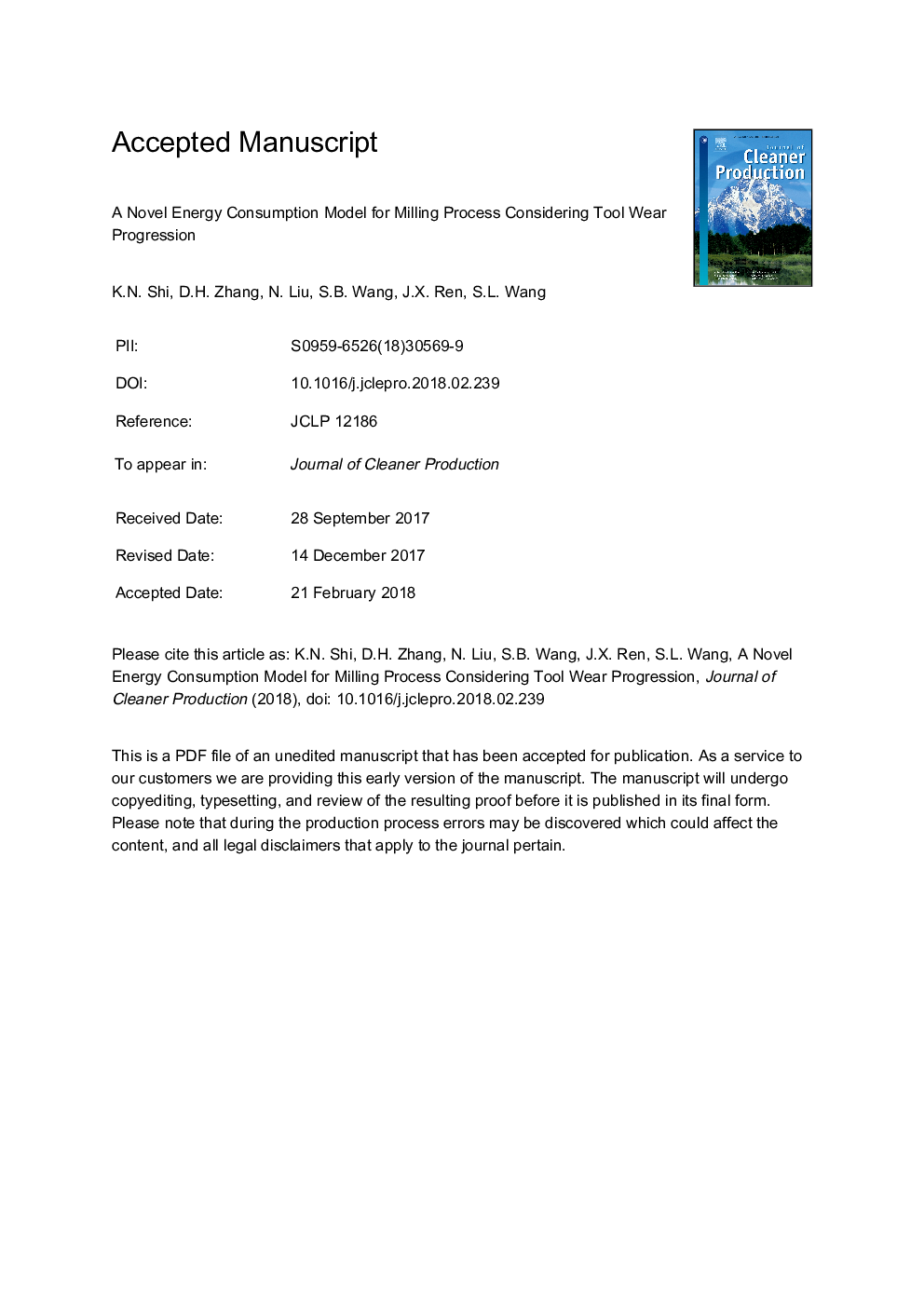| کد مقاله | کد نشریه | سال انتشار | مقاله انگلیسی | نسخه تمام متن |
|---|---|---|---|---|
| 8096630 | 1522069 | 2018 | 22 صفحه PDF | دانلود رایگان |
عنوان انگلیسی مقاله ISI
A novel energy consumption model for milling process considering tool wear progression
ترجمه فارسی عنوان
مدل مصرف انرژی جدید برای فرایند فرز با توجه به پیشرفت سایش ابزار
دانلود مقاله + سفارش ترجمه
دانلود مقاله ISI انگلیسی
رایگان برای ایرانیان
کلمات کلیدی
بهره وری انرژی، مدلسازی مصرف انرژی، سایش ابزار، فرآیند فرز، قدرت برش،
ترجمه چکیده
بحران انرژی، تغییرات آب و هوایی، و قوانین سختگیرانه فشار زیادی بر شرکت ها، به ویژه بخش های تولید، برای بهبود بهره وری انرژی خود اعمال می کنند. برای دستیابی به کارایی بیشتر انرژی در تولید، مدلسازی انرژی قابل اعتماد، پیش نیاز است، زیرا اساسا پایه ای برای بهینه سازی مربوط به بهره وری انرژی ارائه می دهد. گرچه سایش ابزار اجتناب ناپذیر است، مدل های مصرف انرژی سنتی با توجه به عواملی که باعث سایش ابزار می شوند، نادیده گرفته می شوند. برای حل این مسئله، این مطالعه یک مدل مصرف انرژی با پیشرفت سایش ابزار برای فرآیند فرزکاری 3 را پیشنهاد می کند. بر اساس نظریه ماشینکاری پیشرفته و دستاوردهای اخیر در مدلسازی مصرف انرژی، مدل پیشنهادی در ابتدا به عنوان بیان با ضرایب ناشناخته مشتق شده است. پس از آن، ضرایب مربوطه بر اساس آزمایش های برش کالیبره می شوند. با استفاده از مدل مصرف انرژی صریح، مصرف انرژی با یک ابزار داده شده تحت شرایط برش جدید می تواند با دقت بالا پیش بینی شود. علاوه بر این، به عنوان مدل نشان می دهد مکالمه یک به یک بین مصرف برق و سایش ابزار، سایش ابزار نیز می تواند به طور موثر از مصرف برق اندازه گیری برآورد شده است. در مقایسه با دیگر روش های مانیتورینگ سایش ابزار مانند انتشار صوتی و ارتعاش، این ابزار برآورد هزینه مصرف ابزار مبتنی بر مصرف انرژی نه تنها ساده، بلکه هزینه مقرون به صرفه است. برای بهترین دانشمندان، مدل مصرف انرژی پیشنهادی با پیشرفت سایش ابزار، اولین مدل است که به لحاظ پیش بینی قدرت و پیش بینی سایش ابزار به طور تجربی مورد تایید قرار گرفته است. به همین ترتیب، مدل پیشنهادی می تواند مکمل قابل توجهی برای مدل سازی مصرف انرژی موجود در فرایند ماشینکاری باشد و ممکن است یک پلت فرم دقیق و جامع برای بهینه سازی انرژی بهره مند شود.
موضوعات مرتبط
مهندسی و علوم پایه
مهندسی انرژی
انرژی های تجدید پذیر، توسعه پایدار و محیط زیست
چکیده انگلیسی
Energy crisis, climate change, and stringent legislations are imposing great pressure on enterprises, especially manufacturing sectors, to improve their energy efficiency. To achieve higher energy efficiency in manufacturing, reliable energy consumption modelling is the prerequisite since it offers fundamental basis for any energy efficiency-related optimization. Although tool wear is inevitable, traditional energy consumption models fail to take tool wear effects into consideration. To address this issue, this study proposes an energy consumption model with tool wear progression for 3-axis milling process. Based on modern machining theory and recent achievements in energy consumption modelling, the proposed model is firstly derived as an expression with unknown coefficients. Subsequently, the involved coefficients are calibrated based on cutting experiments. With the explicit energy consumption model, power consumption with a given tool wear under new cutting conditions can be predicted with a high accuracy. In addition, as the model reveals a one-to-one correspondence between the power consumption and tool wear, the tool wear can also be effectively estimated from the measured power consumption. Compared with other tool wear monitoring methods such as acoustic emission and vibration, this power consumption-based tool wear estimation method is not only straightforward but also cost-effective. To the best of the authors' knowledge, the proposed energy consumption model with tool wear progression is the first model that was experimentally validated in terms of total power prediction and tool wear prediction, respectively. As such, the proposed model can be a significant supplement to existing energy consumption modelling in machining process, and may provide a more accurate and comprehensive platform for energy efficiency optimization.
ناشر
Database: Elsevier - ScienceDirect (ساینس دایرکت)
Journal: Journal of Cleaner Production - Volume 184, 20 May 2018, Pages 152-159
Journal: Journal of Cleaner Production - Volume 184, 20 May 2018, Pages 152-159
نویسندگان
K.N. Shi, D.H. Zhang, N. Liu, S.B. Wang, J.X. Ren, S.L. Wang,
